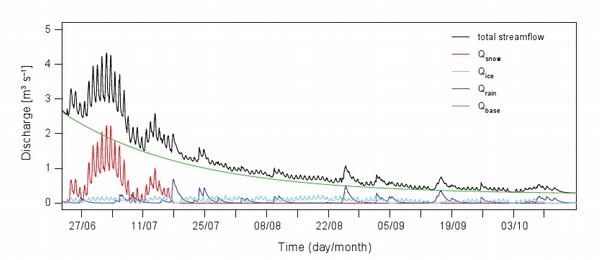Predicting natural disasters in order to inform and warn populations residing in risk zones is a major challenge today. “Mathematical models exist, but they still don’t take into account all the data that are needed to establish reliable predictions, such as the influence of air temperature, the formation of thermal winds or the impact of precipitation,” explains Professor Marc Parlange. The project his team started in 2008 with a single weather station has grown, and today the stations spread over more than 20 square kilometers, covering a large part of the Val Ferret watershed. Working in the mountains requires a specific set of skills. The weather stations are installed in strategic but often hard to reach locations in the valley, whose altitude difference from bottom to top is 800 to 1,000m. Perhaps not coincidentally, there are many mountaineers in Parlange’s lab: “Doing experiments in mountainous regions is very physically demanding. The PhDs working here are very fit.”
Finding the right river
It’s not by chance that EFLUM’s research is taking place in the Val Ferret. Raphaël Mutzner, the PhD student responsible for hydrologic modeling, explains that there weren’t many options. “The condition was to find a river that hadn’t been subjected to human influence, to ensure that there weren’t any dams that would alter its output. Amazingly enough, it was extremely difficult to find one, even when we extended our search over the entire country. The Dranse river in the Val Ferret is ideal; it flows freely through a small, pristine valley. One side of the watershed is characterized by gentle slopes and the other has steep, rocky outcrops. There is a small glacier in the upper valley.” During this new experiment campaign, Mutzner will take ice and groundwater samples. He had previously also taken snow samples, which will enable him to isolate the isotope signature of the Dranse and thus determine the precise influence of various sources of water on the river.

Winds and slopes
But the influence of water input is not the only thing that makes the flow rate fluctuate. Winds also play an important role. “I’m trying to understand slope winds, which flow upslope in the daytime and downslope at night. How do they form, and when? What is their influence on evaporation? My goal is to be able to predict these winds using a new-generation model,” says PhD student Daniel Nadeau. Many tools have been deployed this summer. In addition to the 25 ground-based stations equipped with numerous sensors, two weather stations on 10m towers have been installed, and a weather balloon will be regularly deployed. Three Lidars, laser-based instruments, will be used to take continuous wind data over a height of nearly 2 km. A better understanding of the hydrology of the Alps will help us better manage the risks that are an inherent part of this magnificent environment.
...



